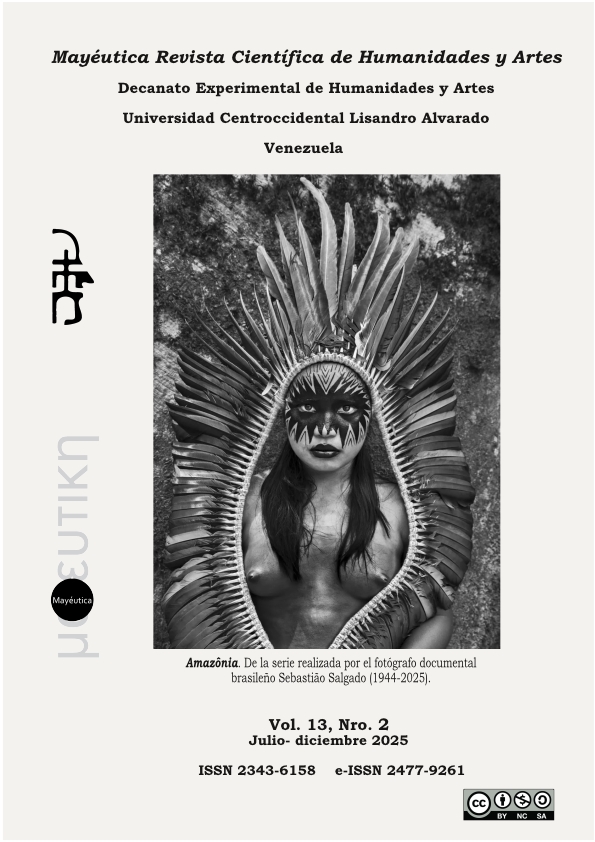Computer modeling of AfricanAmerican oral tradition music: the example of Relative Patterns
DOI:
https://doi.org/10.5281/zenodo.15859102Keywords:
Rhythmic modeling, assisted composition, African American music, data visualization, rhythmic imparityAbstract
The article describes the creative process of the series of electroacoustic works Relative Patterns by composer Fredy Vallejos, taking as a starting point the notion of a model applied to musical composition, through computer tools (in particular computer-assisted composition and with electroacoustic means). After a historical and conceptual introduction to the compositional writing used in the series, the elements necessary for a rhythmic formalization that serve as a basis for the structuring of the compositions will be detailed. This formalization is based mainly on the interpretation of models proposed by musicologist Shimha Arom for the analysis of Central African music, transcribed into the traditional and proportional notation system through the Open Music programming environment. Likewise, this article exposes the compositional elements of the Relative Patterns series that are not present in music of African origin, as well as the different forms of confrontation between traditional music and written or experimental music.
Downloads
References
Alvarado, M. (2022). Al otro lado del rio: Músicas Tradicionales de Marimba de Chonta del Pacífico Sur Colombiano. University of Music Franz Liszt.
Arom, S. (1985). Polyphonies et polyrythmies instrumentales d’Afrique centrale. Structure et méthodologie. (Vol. 1 y 2).Selaf.
Bosseur, J. Y. (2022). Musiques traditionnelles et création contemporaine. Coll. Musique ouverte.
Borges, J.L. (2024). El tamaño de mi esperanza. Medium. (Obra original publicada en1926).
Boulez, P. (1963). Penser la musique aujourd’hui. Gonthier.
Chang, L. (2007). Ligeti, György. Quand le temps devient espace. L’Harmattan.
Chemilier, M. (2007). Mathématiques de tradition orale. Mathematics and Social Science, 45 (178) 11- 40.
Decarsin, F. (2001). La musique, architecture du temps. L’Harmattan.
Duque García, A. (2026). A mano Limpia. Instituto Departamental de Bellas Artes.
Eiriz, C. (2012). Una guía comentada acerca de la tipología y la morfología de Pierre Schaeffer. Cuaderno 39. Centro de Estudios en Diseño y Comunicación.
Emeri, E. (1998). Temps et Musique. L’Age d’Homme.
Lelong, G. (2008). Gerard Grisey, écrits ou l’invention de la musique spectrale. Editions MF.
Ligeti, G. (2001), Neuf essais sur la musique. Contrechamps Editions.
Michael, P. (1995). Gyorgy Ligeti. Minerve.
Orlarey, Y. y Pottier, L. (Eds). (2009). Entre Calcul, Programmation et Création. L’Université de Saint-Étienne.
Páez, Y. (2008). Adaptación de los toques Afrocubanos a la batería y al set de percusión. AB Música.
Reich, S. (2002). Writing on music, 1965-2000. Oxford University Press.
Schaeffer, P. (1959). ¿Qué es la música concreta? Editorial Nueva Visión.
Tascón, H. (2008). A marimbiar: metodo OIO para tocar la marimba de chonta. Fondo Mixto para la Cultura y las Artes del Valle del Cauca
Thul, E., Toussaint, G. T. (2008). Analysis of musical rhythm complexity measures in a cultural context. Proceedings of the Canadian Conference on Computer Science and Software Engineering.
Touretzky, D. (1990) Common Lisp: A Gentle Introduction to Symbolic Computation. Carnegie Mellon University.
Toussaint, G. (2002). A Mathematical Analysis of Africain, Brazilian and Cuban Clave Rhtytms. Bridges: Mathematical Connections in Art, Music, and Science. Bridges Conference.
Published
How to Cite
Issue
Section

This work is licensed under a Creative Commons Attribution-NonCommercial-ShareAlike 4.0 International License.





